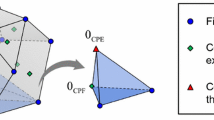Abstract
In the finite element method (FEM), a necessary condition for a four-node isoparametric element is that no interior angle is greater than 180° and the positivity of Jacobian determinant should be ensured in numerical implementation. In this paper, we incorporate cell-wise strain smoothing operations into conventional finite elements and propose the smoothed finite element method (SFEM) for 2D elastic problems. It is found that a quadrilateral element divided into four smoothing cells can avoid spurious modes and gives stable results for integration over the element. Compared with original FEM, the SFEM achieves more accurate results and generally higher convergence rate in energy without increasing computational cost. More importantly, as no mapping or coordinate transformation is involved in the SFEM, its element is allowed to be of arbitrary shape. Hence the restriction on the shape bilinear isoparametric elements can be removed and problem domain can be discretized in more flexible ways, as demonstrated in the example problems.
Similar content being viewed by others
References
Bathe KJ (1996) Finite element procedures. Prentice Hall, New Jersey
Beissel S, Belytschko T (1996) Nodal integration of the element - free Galerkin method. Comput Meth Appl Mech Eng 139:49–74
Belytschko T, Lu YY, Gu L (1994) Element-free Galerkin methods. Int J Numer Method Eng 37:229–256
Belytschko T, Krongauz Y, Organ D, Fleming M, Krysl P (1996) Meshless Method: An Overview and Recent Developments. Comput Meth Appl Mech Eng 139:3–47
Bonet J, Kulasegaram S (1999) Correction and stabilization of smooth particle hydrodynamics methods with applications in metal forming simulation. Int J Numer Method Eng 47:1189–1214
Chen JS, Wu CT, Belytschko T (2000) Regularization of material instabilities by meshfree approximations with intrinsic length scales. Int J Numer Method Eng 47:1303–1322
Chen JS, Wu CT, Yoon S, You Y (2001) A stabilized conforming nodal integration for Galerkin meshfree method. Int J Numer Method Eng 50:435–466
Dai KY, Liu GR, Lim KM, Gu YT (2003) Comparison between the radial point interpolation and the Kriging based interpolation used in mesh-free methods. Comput Mech 32:60–70
Krongauz Y, Belytschko T (1997) Consistent pseudo-derivatives in meshless method. Int J Numer Method Eng 146:371–386
Li Y, Liu GR, Luan MT, Dai KY, Zhong ZH, Li GY, Han X (2006) Contact analysis for solids based on linearly conforming RPIM. Comput Mech (in press)
Liu GR (2002) Mesh-free methods: moving beyond the finite element method. CRC Press, Boca Raton
Liu GR, Li Y, Dai KY, Luan MT, Xue W (2006a) A linearly conforming RPIM for 2D solid mechanics. Int J Comput Methods (in press)
Liu GR, Quek SS (2003) The finite element method: a practical course. Butterworth Heinemann, Oxford
Liu GR, Zhang GY, Dai KY, Wang YY, Zhong ZH, Li G, Han X (2006b) A linearly conforming point interpolation method (LC-PIM) for 2D solid mechanics problems. Int J Comput Methods (in press)
Liu WK, Jun S, Zhang YF (1995) Reproducing kernel particle methods. Int J Numer Method Eng 20:1081–1106
Monaghan JJ (1982) Why particle methods work. Siam J Sci Sat Comput 3(4):423–433
Sukumar N (2004) Construction of polygonal interpolants: a maximum entropy approach. Int J Numer Method Eng 61:2159–2181
Sukumar N, Moran B (1999) C 1 natural neighbor interpolation for partial differential equations. Numer Methods Partial Differential Equations 15:417
Sukumar N, Moran B, Belytschko T (1998) The natural element method in solid mechanics. Int J Numer Method Eng 43:839–887
Sukumar N, Tabarraei (2004) Conforming polygonal finite elements. Int J Numer Method Eng 61:2045–2066
Timoshenko SP, Goodier JN (1970) Theory of elasticity, 3rd edn. McGraw-Hill, New York
Wang JG, Liu GR (2002) A point interpolation meshless method based on radial basis functions. Int J Numer Method Eng 54:1623–1648
Yoo JW, Moran B, Chen JS (2004) Stabilized conforming nodal integration in the natural-element method. Int J Numer Method Eng 60:861–890
Zienkiewicz OC, Taylor RL (2000) The finite element method, 5th edn. Butterworth Heinemann, Oxford
Author information
Authors and Affiliations
Corresponding author
Rights and permissions
About this article
Cite this article
Liu, G.R., Dai, K.Y. & Nguyen, T.T. A Smoothed Finite Element Method for Mechanics Problems. Comput Mech 39, 859–877 (2007). https://doi.org/10.1007/s00466-006-0075-4
Received:
Accepted:
Published:
Issue Date:
DOI: https://doi.org/10.1007/s00466-006-0075-4




